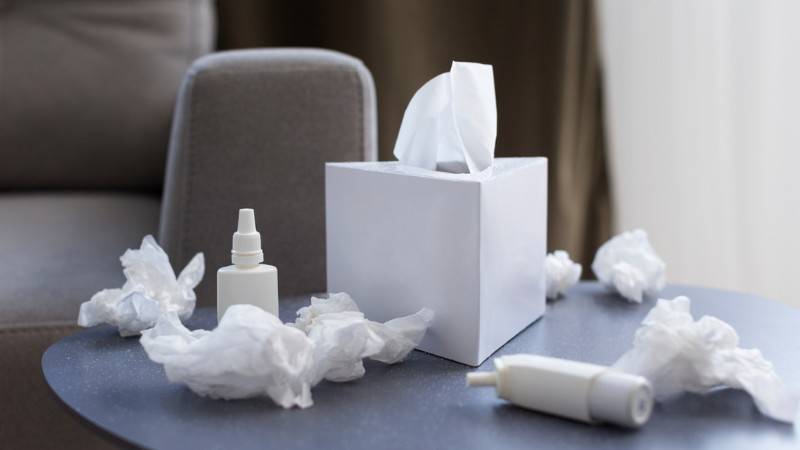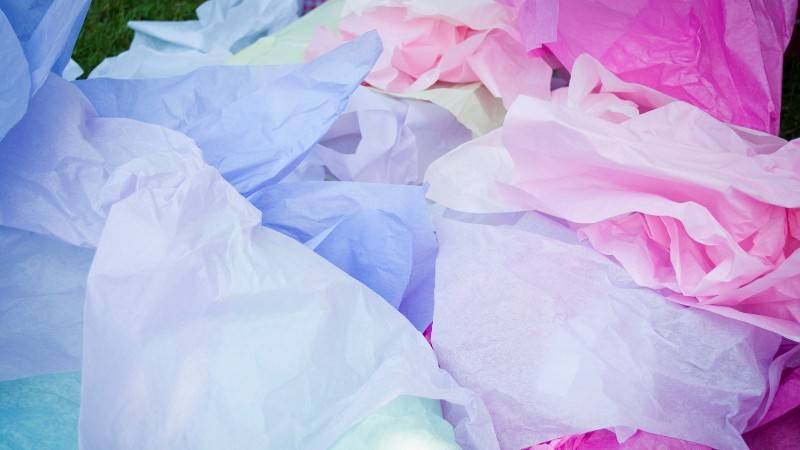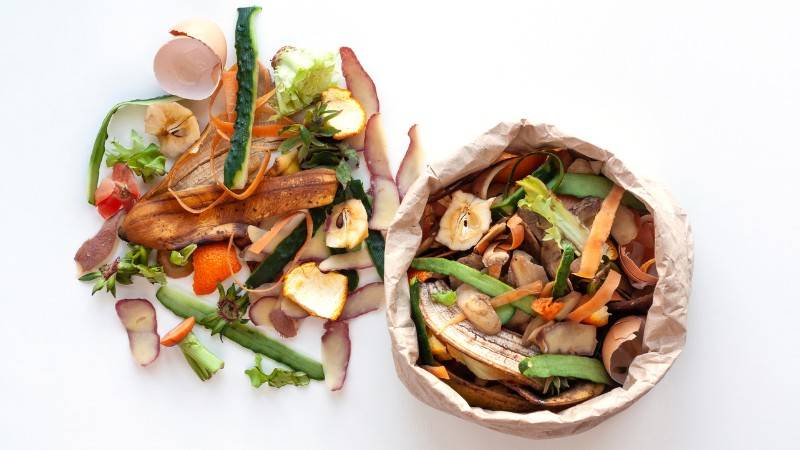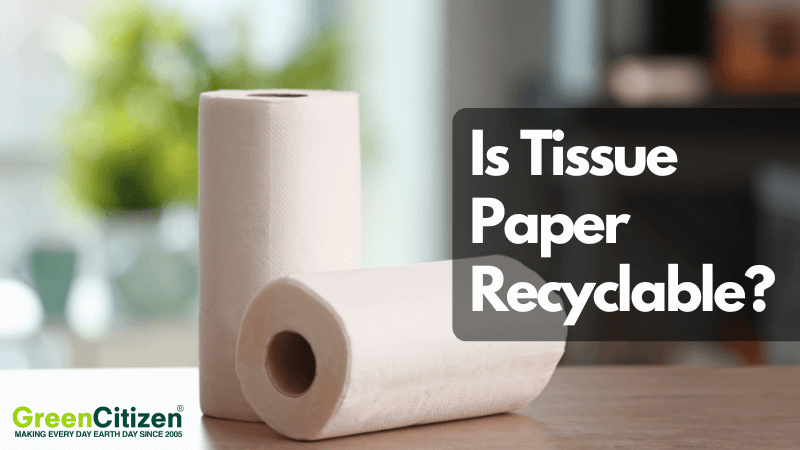Right now, our planet is facing some serious challenges when it comes to waste and recycling. It’s overwhelming, I know.
But did you ever stop to think about the small everyday items, like tissue paper?
I can’t help but notice how tissue paper pops up everywhere in our lives – from wrapping gifts to our daily hygiene.
But with our collective aim to lead greener lives, many of you have shot me the same pressing question: “Is tissue paper recyclable?”
It’s a valid concern.
As someone who’s been digging into recycling topics for a decade, I’m thrilled to shed some light on this. So, let’s dive right into unraveling the mystery behind the recyclability of our everyday tissue and paper products!
Can You Recycle Tissue Paper?
Technically, it is possible to recycle tissue paper, but not in a practical sense. Tissue paper is recyclable as long as it hasn’t been mixed up with contaminants like glitter, foil, oil, or any shiny coating.
Because these contaminants disrupt the recycling process, if you’re considering recycling your tissue paper, ensure it’s free from these decorative extras. Pure, unadulterated tissue paper is what recycling centers ideally need.
But we mainly use tissue paper to clean things, right?
So how can there be “pure, unadulterated” tissue paper that you can send for recycling?

Also, not every recycling center has the machinery or set up to handle tissue paper. So, before you enthusiastically toss tissue paper into the recycling bin, do me a favor: give your local recycling center a ring and confirm if they accept tissue paper.
Small steps, but they make a big difference!
Why Recycling Tissue Paper Is NOT Practical
Alright, friends, while we’re all in for a greener tomorrow, it’s essential to know that some items, despite being recyclable in theory, aren’t always practical to recycle.
Let’s take a deeper look into why recycling tissue paper often falls into this category:
The Contamination Challenge
More often than not, used tissue paper doesn’t come to recycling centers as a pristine, clean product.
From wiping hands to removing makeup or even cleaning up spills, by the time tissue paper has done its job, it’s loaded with contaminants.
This contamination means recycling it would require an intensive cleaning process, often rendering it not worth the effort and resources.
The Colored Tissue Paper Complexity
Remember that vibrant, blue tissue paper you used for your friend’s birthday gift?

While it sure looked festive, colored or dyed tissue paper introduces another layer of complexity in recycling. Extracting and neutralizing these dyes to produce a neutral-colored recycled tissue paper product can be energy-intensive and not always successful.
Oils, Makeup, and More
One might think a quick wipe with tissue paper doesn’t harm, but the reality is a bit different.
Tissues easily absorb oils, makeup, creams, and even the occasional ink from leaky pens. These are not just contaminants but can sometimes be non-recyclable components.
Imagine trying to recycle a tissue soaked in waterproof mascara. Tricky, isn’t it?
The Shortcomings of Short Fibers
Here’s a fun fact: paper items, including tissue paper, have a recycling “life cycle.” Each time paper gets recycled, its fibers get shorter.
Tissue paper, being on the tail end of this life cycle, has fibers that are already quite short. By the time it’s been used, these fibers often become too short to produce a quality recycled paper product. This makes the recycling process less efficient and sometimes not feasible.
While the intention behind recycling tissue paper is noble, the real-world challenges often make it impractical. The goal isn’t just to recycle but to do so efficiently, with minimal wastage, ensuring we truly contribute to a sustainable future.
As always, the best policy might be to reduce and reuse before we think of recycling.
Is Tissue Paper Compostable?
Good news! Yes, tissue paper is compostable. And if you’re wondering, “Is tissue paper biodegradable?” The answer is a resounding yes again.
When you add tissue paper to your compost pile, you’re introducing carbon-rich “brown” material. This helps balance out the nitrogen-heavy “green” materials, like kitchen scraps and lawn clippings. A balanced compost mix is essential for efficient decomposition, and it ensures the resulting compost is nutrient-rich, perfect for nourishing plants.

Considering the recycling challenges associated with tissue paper, composting emerges as a more practical and eco-friendly option.
Instead of trying to recycle tissue paper with all its contaminants, composting tissue paper allows it to naturally break down, returning valuable nutrients to the earth.
A question that often pops up is about the decomposition rate of tissue paper. Due to its thin nature, tissue paper has a relatively swift breakdown rate in compost piles.
In an efficiently managed compost setting, you might find that tissue paper disintegrates in anywhere from a few weeks to a couple of months.
Of course, several factors can influence this, such as the climate, composting techniques, and the specific conditions of the compost heap.
While recycling tissue paper might be a challenge, composting emerges as a brilliant alternative. Every time you toss used tissue paper into the compost, you’re ensuring a full-circle journey, from the earth and back to it, with minimal waste.
How to Compost Tissue Paper at Home
- Separate Clean from Contaminated: Before adding tissue paper to your compost, ensure it’s free from heavy contaminants like oils or makeup. While a bit of lipstick or a smudge of foundation won’t harm, excessively soiled tissues should be excluded.
- Shred the Tissue: Tear the tissue paper into smaller pieces. This increases its surface area and helps it break down faster in the compost pile.
- Balance with Green Waste: For every bit of tissue paper (brown, carbon-rich material) you add, balance it with some green waste like vegetable peels or grass clippings. This ensures that the compost remains balanced and decomposes efficiently.
- Turn Your Compost: Every week, give your compost pile or bin a good stir. This introduces air, which aids in the decomposition process and prevents foul odors.
- Monitor Moisture Levels: The compost pile should feel like a wrung-out sponge – moist but not dripping. If it feels too dry, sprinkle some water. If it’s too wet, add more dry materials like tissue paper or dried leaves.
- Wait and Harvest: Over time, the bottom of your compost pile will transform into a dark, crumbly, soil-like substance. This is the gold standard of compost! You can now use it to enrich your garden soil.
There you have it!
By embracing the art of composting tissue paper at home, you’re taking an active role in enhancing your garden’s health and doing wonders for the planet.
So, the next time you have a pile of tissue papers after a party or gathering, remember your garden could use that carbon boost.
Creative Ways to Reuse Tissue Paper
Repurposing items, especially something as versatile as tissue paper, can be both fun and environmentally friendly. Reusing reduces waste and provides an opportunity to channel our creativity into something delightful. Let’s explore some imaginative ways to give a second life to our used tissue paper:
Gift Wrapping
With a little care, tissue paper can be smoothed out and reused as gift wrapping or filler for gift bags. Add a personal touch by stamping or drawing on it.
Tissue Paper Flowers
Craft colorful and vibrant flowers using tissue paper. They make for charming home décor or can be used to spruce up gift packages. With a bit of twisting and fluffing, you can create roses, dahlias, or any floral variety that strikes your fancy.
Papier-mâché
Dive into the nostalgic craft of papier-mâché using tissue paper. Whether it’s decorative bowls, masks, or sculptures, this craft offers endless possibilities.
Decorative Luminaries
Make delicate luminaries by gluing pieces of colored tissue paper onto glass jars. Once dried, place a tea light inside, and the colorful patterns will cast a beautiful glow.
Tissue Paper Garland
String together tissue paper tassels to create festive garlands. Perfect for parties, celebrations, or just adding a dash of fun to your living space.
Bookmarks
Create unique and lightweight bookmarks using tissue paper. Layer them, add a touch of paint or some glitter, and laminate for durability.
Suncatchers
Using a mix of colored tissue papers, craft beautiful suncatchers that can be hung by the window. When sunlight passes through, it casts delightful, colorful reflections.
Confetti
Don’t discard those tiny tissue paper offcuts. Instead, punch out shapes or simply tear them to create confetti for celebrations.
Collage Art
Get artsy by using tissue paper in collages. Mix different colors and textures to create stunning artwork for your walls.
Custom Envelopes
Add a personal touch to your letters by crafting custom envelopes lined with tissue paper. It not only looks good but also adds an extra layer of cushioning.
Remember, creativity knows no bounds! With a sprinkle of imagination and a dash of effort, tissue paper can be transformed into delightful crafts and functional items. It’s not just about reusing; it’s about reimagining the potential of what we often overlook.
So, next time you’re about to toss that tissue paper, think of the endless creative possibilities it holds!
Frequently Asked Questions (FAQ)
No, due to potential contamination and its short fibers, tissue paper is generally not recommended for recycling.
The best methods are composting it or disposing of it with your general waste.
No, tissue paper should not be placed in the recycling bin because of potential contamination.
Tissue paper is biodegradable, but it’s not typically recyclable due to reasons like contamination and fiber length. Composting is a preferred disposal method.
Conclusion
In our quest to understand, “Is tissue paper recyclable?”, we’ve uncovered some intriguing insights. While tissue paper, in its purest form, might be accepted in the recycling process, it often faces challenges like contamination and short fibers. However, the joyous news is that it’s biodegradable and can be effectively composted.
Recycled paper, especially when it comes to wrapping paper or other types, usually has clearer guidelines. Still, with tissue paper, the emphasis shifts towards reuse and composting. Finding creative avenues to reuse tissue paper, whether in crafts or as an aesthetic touch to gifts, showcases its versatility beyond just its original purpose.
But what about the general concept of paper recyclable practices? Most paper, like wrapping paper and other recyclable paper types, undergo a transformation into paper pulp, setting the stage for its rebirth into new paper products. Yet, it’s essential to discern which types are best suited for the recycling bin and which should be composted or repurposed.
As we embrace these sustainable choices, let’s prioritize our planet’s well-being and be discerning in how we handle tissue paper and other paper products.

